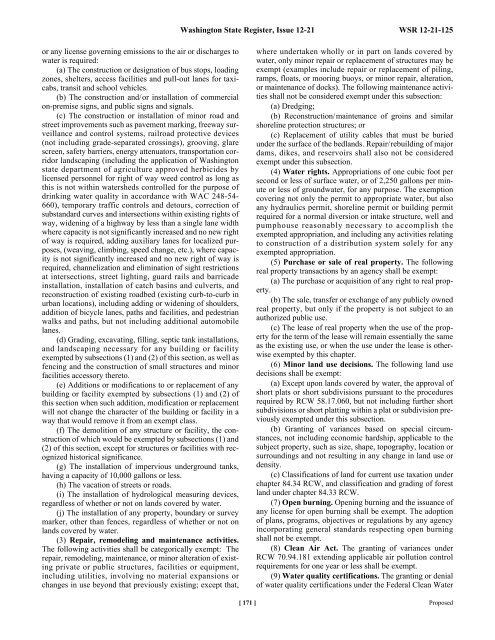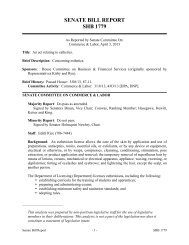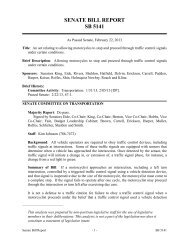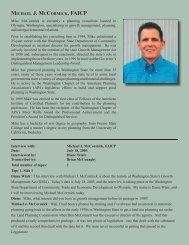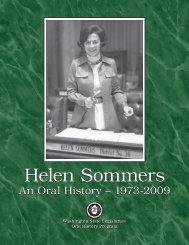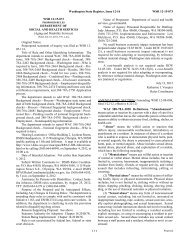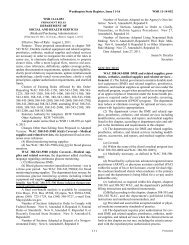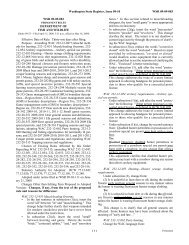Proposed
Proposed
Proposed
You also want an ePaper? Increase the reach of your titles
YUMPU automatically turns print PDFs into web optimized ePapers that Google loves.
or any license governing emissions to the air or discharges to<br />
water is required:<br />
(a) The construction or designation of bus stops, loading<br />
zones, shelters, access facilities and pull-out lanes for taxicabs,<br />
transit and school vehicles.<br />
(b) The construction and/ or installation of commercial<br />
on-premise signs, and public signs and signals.<br />
(c) The construction or installation of minor road and<br />
street improvements such as pavement marking, freeway surveillance<br />
and control systems, railroad protective devices<br />
(not including grade-separated crossings), grooving, glare<br />
screen, safety barriers, energy attenuators, transportation corridor<br />
landscaping (including the application of Washington<br />
state department of agriculture approved herbicides by<br />
licensed personnel for right of way weed control as long as<br />
this is not within watersheds controlled for the purpose of<br />
drinking water quality in accordance with WAC 248-54-<br />
660), temporary traffic controls and detours, correction of<br />
substandard curves and intersections within existing rights of<br />
way, widening of a highway by less than a single lane width<br />
where capacity is not significantly increased and no new right<br />
of way is required, adding auxiliary lanes for localized purposes,<br />
(weaving, climbing, speed change, etc.), where capacity<br />
is not significantly increased and no new right of way is<br />
required, channelization and elimination of sight restrictions<br />
at intersections, street lighting, guard rails and barricade<br />
installation, installation of catch basins and culverts, and<br />
reconstruction of existing roadbed (existing curb-to-curb in<br />
urban locations), including adding or widening of shoulders,<br />
addition of bicycle lanes, paths and facilities, and pedestrian<br />
walks and paths, but not including additional automobile<br />
lanes.<br />
(d) Grading, excavating, filling, septic tank installations,<br />
and landscaping necessary for any building or facility<br />
exempted by subsections (1) and (2) of this section, as well as<br />
fencing and the construction of small structures and minor<br />
facilities accessory thereto.<br />
(e) Additions or modifications to or replacement of any<br />
building or facility exempted by subsections (1) and (2) of<br />
this section when such addition, modification or replacement<br />
will not change the character of the building or facility in a<br />
way that would remove it from an exempt class.<br />
(f) The demolition of any structure or facility, the construction<br />
of which would be exempted by subsections (1) and<br />
(2) of this section, except for structures or facilities with recognized<br />
historical significance.<br />
(g) The installation of impervious underground tanks,<br />
having a capacity of 10,000 gallons or less.<br />
(h) The vacation of streets or roads.<br />
(i) The installation of hydrological measuring devices,<br />
regardless of whether or not on lands covered by water.<br />
(j) The installation of any property, boundary or survey<br />
marker, other than fences, regardless of whether or not on<br />
lands covered by water.<br />
(3) Repair, remodeling and maintenance activities.<br />
The following activities shall be categorically exempt: The<br />
repair, remodeling, maintenance, or minor alteration of existing<br />
private or public structures, facilities or equipment,<br />
including utilities, involving no material expansions or<br />
changes in use beyond that previously existing; except that,<br />
Washington State Register, Issue 12-21 WSR 12-21-125<br />
where undertaken wholly or in part on lands covered by<br />
water, only minor repair or replacement of structures may be<br />
exempt (examples include repair or replacement of piling,<br />
ramps, floats, or mooring buoys, or minor repair, alteration,<br />
or maintenance of docks). The following maintenance activities<br />
shall not be considered exempt under this subsection:<br />
(a) Dredging;<br />
(b) Reconstruction/ maintenance of groins and similar<br />
shoreline protection structures; or<br />
(c) Replacement of utility cables that must be buried<br />
under the surface of the bedlands. Repair/ rebuilding of major<br />
dams, dikes, and reservoirs shall also not be considered<br />
exempt under this subsection.<br />
(4) Water rights. Appropriations of one cubic foot per<br />
second or less of surface water, or of 2,250 gallons per minute<br />
or less of groundwater, for any purpose. The exemption<br />
covering not only the permit to appropriate water, but also<br />
any hydraulics permit, shoreline permit or building permit<br />
required for a normal diversion or intake structure, well and<br />
pumphouse reasonably necessary to accomplish the<br />
exempted appropriation, and including any activities relating<br />
to construction of a distribution system solely for any<br />
exempted appropriation.<br />
(5) Purchase or sale of real property. The following<br />
real property transactions by an agency shall be exempt:<br />
(a) The purchase or acquisition of any right to real property.<br />
(b) The sale, transfer or exchange of any publicly owned<br />
real property, but only if the property is not subject to an<br />
authorized public use.<br />
(c) The lease of real property when the use of the property<br />
for the term of the lease will remain essentially the same<br />
as the existing use, or when the use under the lease is otherwise<br />
exempted by this chapter.<br />
(6) Minor land use decisions. The following land use<br />
decisions shall be exempt:<br />
(a) Except upon lands covered by water, the approval of<br />
short plats or short subdivisions pursuant to the procedures<br />
required by RCW 58.17.060, but not including further short<br />
subdivisions or short platting within a plat or subdivision previously<br />
exempted under this subsection.<br />
(b) Granting of variances based on special circumstances,<br />
not including economic hardship, applicable to the<br />
subject property, such as size, shape, topography, location or<br />
surroundings and not resulting in any change in land use or<br />
density.<br />
(c) Classifications of land for current use taxation under<br />
chapter 84.34 RCW, and classification and grading of forest<br />
land under chapter 84.33 RCW.<br />
(7) Open burning. Opening burning and the issuance of<br />
any license for open burning shall be exempt. The adoption<br />
of plans, programs, objectives or regulations by any agency<br />
incorporating general standards respecting open burning<br />
shall not be exempt.<br />
(8) Clean Air Act. The granting of variances under<br />
RCW 70.94.181 extending applicable air pollution control<br />
requirements for one year or less shall be exempt.<br />
(9) Water quality certifications. The granting or denial<br />
of water quality certifications under the Federal Clean Water<br />
[ 171 ] <strong>Proposed</strong>


